PSYCH 133A: Adolescent Development Exam I
1/99
There's no tags or description
Looks like no tags are added yet.
Name | Mastery | Learn | Test | Matching | Spaced |
|---|
No study sessions yet.
100 Terms
Adolescence Start and End
Begins: Onset of puberty
Ends: societal and cultural implications
Define Adolescence
The second decade of life marked by multiple transitions
(physical and reproductive maturation, increased independence from parents, heightened peer orientation, elevated risk taking, and identity formation)
to grow towards
ad: towards
escence: growth
Preparation to become member of society, a thinking individual
Positives and Negatives of Prolonged Adolescence
Positives: more time to find your interests, identity, and career, as well as to educate yourself
Negatives: difficulties in gaining psychological independence from parents
Adolescence as Distinct Period in Development
Universally tied to biological development
Puberty and rapid physical growth
Unique feats of brain development
Socially and culturally defined and structured
Family, schooling, and work
Often involves rites of passage
Changes historically
Economic system and conditions are significant
G Stanley Hall (1844-1924) – Father of Developmental Psychology
Integrated Darwin’s emphasis of struggle humans underwent as a species
“...Ontogeny recapitulates phylogeny” – development of specific individual mimics evolution of species
Evolution embedded in genetic structure, to be repeated as one grows older
Sequential, infallible– cannot skip one
Storm and stress
Describe the emotional turmoil, conflict, and risk-taking behavior he observed as characteristic of adolescence.
Anna Freud – Daughter of Sigmund Freud
Took ideology of Sigmund Freud and applied it towards the adolescence stage
Sexual drives disappearing in latency stage reawakes, however ego not fully developed and uncontrollable
Adolescence is a developmental disturbance
Emphasis of biological innateness, like hall
Unlike Hall, felt there was something that could be done – distancing
“...Nothing helps here except the complete discarding of the love objects of the child, that is, the parents.”
Margaret Mead (1901-1978)
Graduate student of Frank Boas
“...Are the disturbances which vex our adolescence due to the nature of adolescence or to civilization? Under different conditions does adolescence present a different picture.”
Evidence of cultural differentiation of adolescence outside of western world
Childhood and adolescence much freer and less worrisome in Samoa, less sexually restricting
Proved adolescence was not biological determined and storm and stress was not universal
Critiques:
Misrepresentation of teenagers in Samoa
Mead distance from villages and only lived there in nine-months
Ruth Benedict (1887-1948)
Although it is a fact of nature that the child becomes a man, the way in which this transition is affected varies from one society to another, and no one of these particular cultural bridges should be regarded as the ‘natural’ path to maturity”
Continuity vs. Discontinuity
Transition from childhood from adulthood more contagious leads to smoother transition
Discontinuous transition, meaning a more disconnected path from childhood to adulthood, leads to much more difficult transition
Continuity vs. Discontinuity
Transition from childhood from adulthood more contagious leads to smoother transition
Discontinuous transition, meaning a more disconnected path from childhood to adulthood, leads to much more difficult transition
Contemporary Views and Model
ADOLESCENCE IS CONTINUOUS IN SOME AND DISCONTINUOUS IN OTHERS
Historical Perspective (John Modell – Social Historian):
Gathering information on day to day lives of normal individuals – from early modern europe to industrial revolution
Early Modern Europe:
Agrarian Society
Family is central economic (and social) unit – often function as self-sustaining unit
Produced what was needed and traded to get whatever else was needed
Continuous, clear, and long transition
Continuous: Children learned whatever needed to succeed as an adult throughout
Gradually acquiring more skills and more responsibilities
Clear: Knew what their life was from the beginning, no mystery
No room for choice or freedom
Long: Owning property (men) or marrying someone with property (women) marker for adulthood
Only way to acquire properties is through inheritance
Industrial Revolution:
Industrial and specialized work
Working for factories outside of home
Family less center as economic unit
Institution taking care of functions that families used to serve
Public schooling – changed nature of adolescence (time of life that needed protection, focusing on character building NOT skillbuilding)
Discontinuous, unclear, shorter transition
Discontinuous: Skills needed to be learned much more quickly, rather than gradually throughout childhood due to schooling and employment
Unclear: More individual choice means future becomes less clear
Historical Perspective (John Modell – Social Historian)
Gathering information on day to day lives of normal individuals – from early modern europe to industrial revolution
Early Modern Europe
Agrarian Society
Family is central economic (and social) unit – often function as self-sustaining unit
Produced what was needed and traded to get whatever else was needed
Continuous, clear, and long transition
Continuous: Children learned whatever needed to succeed as an adult throughout
Gradually acquiring more skills and more responsibilities
Clear: Knew what their life was from the beginning, no mystery
No room for choice or freedom
Long: Owning property (men) or marrying someone with property (women) marker for adulthood
Only way to acquire properties is through inheritance
Industrial Revolution
Industrial and specialized work
Working for factories outside of home
Family less center as economic unit
Institution taking care of functions that families used to serve
Public schooling – changed nature of adolescence (time of life that needed protection, focusing on character building NOT skillbuilding)
Discontinuous, unclear, shorter transition
Discontinuous: Skills needed to be learned much more quickly, rather than gradually throughout childhood due to schooling and employment
Unclear: More individual choice means future becomes less clear
Main Conclusions (John Modell)
Dominant economy helps to define adolescence, descriptively, and prescriptively
Experience of adolescence closely tied to structure of adult society
Societal and cultural differences may be partly due to the dominant economic system
Urie Bronfenbrenner (Bioecological Model)
An individual's development is influenced by a series of interconnected environmental systems
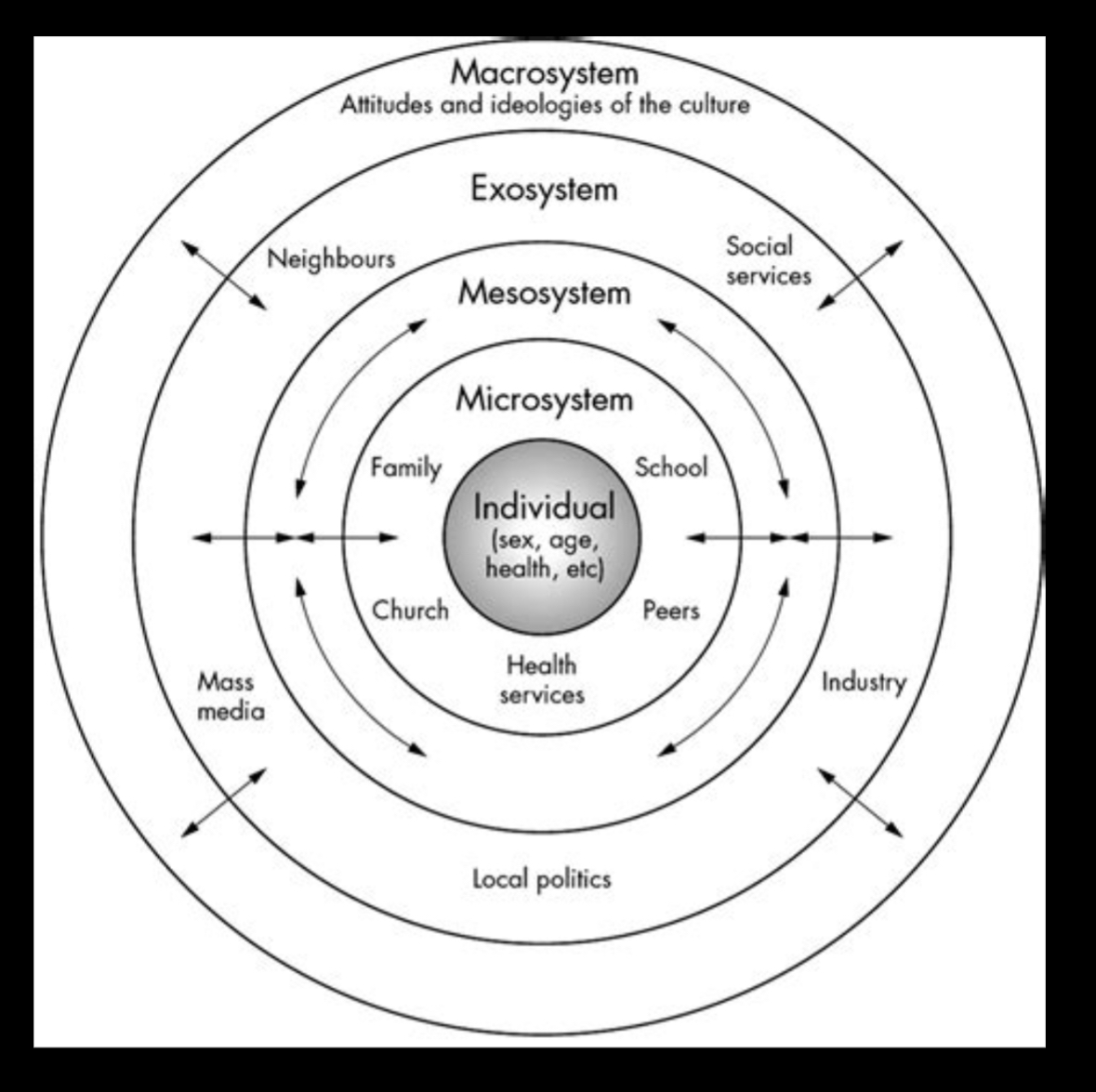
Cynthia Garica-Coll (Integrative Model)
ecological structures (social, economic) differentially affects individuals
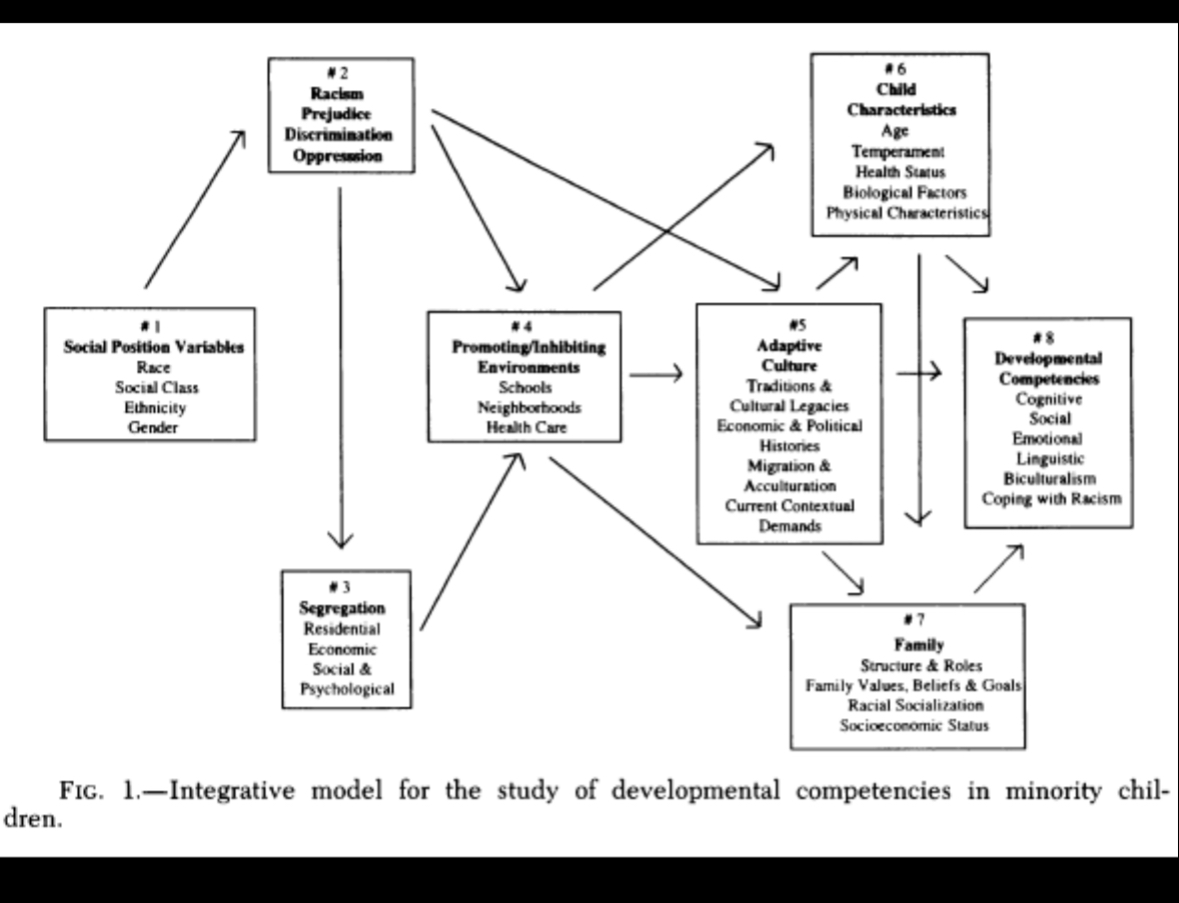
Communicating and Applying Science
Communication of the science of adolescence
“Promise of Adolescence”: census on summarizations of studies done on adolescence + suggests what can be done to best support adolescence
Building Opportunities: surveying the public opinion on adolescence when trying to communication science
Building Opportunities into Adolescence:
Some Cultural Models of Adolescence
When it really starts to matter
Dangerous times
Biological takeover
Stress makes you stronger
Peers matter most
Parents as authorities, equal, scaffolder
Scaffold refers to support without being overbearing
Modernity as threat and progress
Culture of poverty
American Ideal: viewing poorness as the poor individual’s fault
Availability of opportunities
Your Views
Emotions felt more than ever before, most of which are influenced through peers
Core Science of Adolescent Development
One way to communicate science is through science, which is still accurate and specific
Learning mentioned throughout: all aspects in course will have to do with social learning in some sense
Not that adolescence will be a negative outcome, but if needs are not met– a negative outcome increased
Biological Changes and Puberty
Puberty:
Key Pubertal Events
Secular Trend
Change throughout historical time
Social Context
Impacts of Early Experience
Social and Psychological Effects
Sleep: affected by pubertal development
Chronotype
Historical Change
School Start Time
Puberty
Key Pubertal Events
Secular Trend
Change throughout historical time
Social Context
Impacts of Early Experience
Social and Psychological Effects
Sleep: affected by pubertal development
Chronotype
Historical Change
School Start Time
Key Pubertal Events during Adolescence
Representation of key events during pubertal development
Activational and organizational effects of puberty
Gradual process, not discrete event
Begins well before adolescent, continuing till mid-20s
Adrenarche (under 10 y.o): HBA Axis matures, resulting in adrenal androgen increase until early 20s
Results in secondary sex characteristics (body hair, etc)
Menarche: HPG Axis reactivates, rising gonadal hormones
Results in breast development, genital development
GnRH signals HPG axis to mature
In this, body fats is necessary (more for women)
Due to this gymnastics and ice skaters are generally shorter
Adrenarche (under 10 y.o)
HBA Axis matures, resulting in adrenal androgen increase until early 20s
Results in secondary sex characteristics (body hair, etc)
Menarche
HPG Axis reactivates, rising gonadal hormones
Results in breast development, genital development
GnRH signals HPG axis to mature…
In this, body fats is necessary (more for women)
Due to this gymnastics and ice skaters are generally shorter
Secular Trend in Pubertal Timing
Gradual decline in menarche across several countries after only under 600 years
OGS (onset of growth spurt) simultaneous went down
PHV (peak height growth) has gone down historically
Due to:
Nutrition: children observed have better diets than in the past
Health: Vaccines are more commonly administered
These earlier onsets will not continue, rate seem to be approaching a flat for biological onset of menarche
Breast budding may occurs earlier, resulting for several factors
Rising levels of animosity
Ingestion of hormones (meat, etc)
Social Context of Pubertal Development
Puberty also a social and cultural process
Sociocultural construal of changes, particularly menarche
How the environment responds to changes
Fear, shame v. Excitement, pride
Anticipatory socialization can make a difference
Studies suggest prior preparations impacts feelings of changes
Stress, excitement, etc
Social reactions to the changing body
Peer popularity
Sexual attention to girls
Fear of physically larger boys
Timing plays a role here
Ethnic variations in the US
Somewhat earlier for African American and [POTENTIALLY] Latina girls
Role of high levels of racial discrimination (stress hastens pubertal process)
Early Experience and Puberty
Adversities lower age of onset of pubertal development, may send single for earlier maturation (for safety and wellbeing): May NOT be evolutionary, simply that stresses kick in the process
Sexual and physical abuse
Parental harshness
Father absence and caretaker transitions
Evolutionary adaptive
/Caveats/
Primarily only examined among girls, focusing on timing of menarche
Potential genetic confounds not always controlled
Those who have experienced adversity have earlier onset upo passing 11 years old as compared to non-impacted peers
Early Life Stress is Associated with Earlier Emergence of Permanent Molars
Molars erupted, on average for females, earlier
As a function of income, children of lower income had molars erupt much earlier than those with higher income
Early adverse childhood experiences (abuse, neglect) predicted earlier molar eruption
Puberty as a Sensitive Period
Puberty can be a period for plasticity, where things can be heavily influenced
Period of self-care (independent of family), social systems
Earlier maturation can lessen window of plasticity available
Psychological and Behavioral Effects of Puberty
Rise in risk for internalizing issues (i.e., anxiety)
Maybe more for females
Exacerbated by stressors
Rise in risk for externalizing issues (i.e., fighting, acting out)
Most evident for timing v. status
Minor distracting and tension with parents
Increased attention to peer evaluation (?)
Sleep Chronotype and Phase-Delay Shift
Sleep begins earlier, goes later in adolescence, then returns to earlier times in 20s (across the two charts)
Sleep Phase-Delay Shift and Sleep Duration
As one becomes older, there is a biological want to sleep later
On weekdays, there is a restriction (school start time)
Sleep across the Lifespan
Sleep time spreads out, meaning there are more individual differences
Efficiency is spread
Sleep Indicators
Duration
Time actually asleep from initial sleep onset to final awakening
Continuity
Sleep onset latency, wakenings, efficiency
Variability
Nightly variability in varies sleep parameters
Quality
Subjective sense of restful and restorative sleep
Historical Change in Sleep
Younger individuals getting less sleep when considering historical context
Fewer percentages report at least 8 hours of sleep
Higher self-derogation and low self-esteem reported too
NOT social media, more so due to emotionality
School Start Time
Changes in circadian rhythm, academic demands, and social expectation creates need to go to bed
School start times are early however, creating a bind on sleep
Seattle delaying their school start times
High schoolers given sleep watches, measuring activity (movement)
Waking up later in 2017 than 2016
Sleep gain is obtained through getting more sleep in the morning
Grades went up when school start times changed and reported feeling less sleepy
Low resource high school (FHS) had less absences and tardies with later start time
Economic Analysis:
Higher rates of car accidents with early starts times
Higher rates of high school graduation with later start times
Leads to economic gains that outweigh the cost
Brain Development During Adolescence
Main Developmental Changes:
Structural and Functional Changes
Connectivity and Plasticity
Implications
Models of Brain Development
Sleep
Early Adversity
Structural Changes
Reduction in Gray Matter — Synaptic Pruning
Removal of unnecessary or unused synapses from the brain – apoptosis
These synapses are made to prepare one for the world
What is unneeded for the environment surrounding you
Can lead to cognitive shortcuts
Possible lead to stereotypes
Happens in different regions at different times
Earlier life has synaptic pruning in the back (occipital, temporal)
Later stages has synaptic pruning towards the front (frontal, parietal)
Increase in White Matter — Myelination
Myelin sheath is increasingly insulated for efficient and much faster singling to the neuron
Think of a extension cord
Greater white matter in males due to larger brain size
Increase in white matter makes brain grow larger in size, not smaller despite reduction of gray matter
Functional Changes
Enhanced Limbic Activation: Motivation and Reward
Systems responsible for motivation, reward, emotions
Higher circulating levels of dopamine during adolescence
Receptors more receiving of dopamine
Pushes individuals to go out to get desired rewards
Enhanced Limbic Activation: Exploration and Learning
Motivation to explore and learn the world
Learning and exploring potential interests
Acting, attraction
Adolescence are better at a game than adults
Motivated to try countless solutions
Greater activation for striatum and hippocampus in adolescence
Connectivity
Working on enhancing some necessary connections between limbic regions while pruning unnecessary ones
Regions are working together going into the adolescence
Functional Connectivity: When one part brain is activated, another part is activated at the same time
Plasticity
Necessary dendritic spines are sent out while others are pruned, or repressed
Neurons can gain and lose ~25% of their connections weekly at puberty
Key Brain Systems and Regions during Adolescence
Brain regions that aid in social cognition and control
Implications
Increased risk taking
Exploratory and flexible learning skills
Abstract and relativistic thinking skills
Social orientation
Increasing social cognition
Increasing cognitive control
Models
Mature activate system and immature contradicting themselves
Giving rise to more dangerous risk taking and mental health experiences
Trends in Cognitive Science:
Dual-system models imply adolescence to be inherently dangerous and emotional
Another representation of adolescent brain development:
Motivational context is necessary to be relevant to adolescence
Reward will not work if not relevant
Social Reorientation Model
Focuses on social cognition
How different parts of brain starts working together in adolescence
Energized by pubertal hormones and dopamine
If dysfunctional, could result in mental health issues (anxiety, etc)
Sleep Quality, Risk Taking, and Brain Function
Sleep prevents interactions of brain to reduce chance of poor behavior
Those with poorer sleep are more likely to engage in risk taking behavior
Ballon Example:
Risk-taking game: Blowing up balloon for a reward, but the risk is it popping
Those with poorer sleep quality pumped balloon significantly more
Higher activation of indium with poorer sleep and more likely to blow up balloon further
Conflict Frequency
Average of actual conflict frequency does not change significantly
resulting in periods of conflict that are resolved, then peaked at a later time
Conflict Intensity
Tension increases on average during conflict, from early to middle adolescence
At high school ages, intensity goes down progressively
Due to struggles with autonomy, more eloquent arguments
Decrease in conflict due to emotional maturity
Gender differences, most tension is more intense with daughters and mothers
Time with Family
Time spent with family significantly decreases in mid-adolescence
Time with friends significantly increases during adolescence
Time is more spent arguing with parents during adolescence
Hence individuals feel conflict increases when it doesn’t on average
Conflicts occur to lessening time spend with children (as parents)
A hard thing for parents to experience
Parental Authority
Asking adolescence their feelings on whether their parents feels their in control
Decrease across adolescence
Less likely to say a parent should make rules later into adolescence
Very little ethnic differences
When parents and adolescents list topics of conflict and disagreements
Mundane issues like chores and curfew v debate about values and morals
When parents and adolescents give their reasoning behind the issue
Parents view issues as conventional and pragmatic (prudential - is that really a smart thing to do..?)
Adolescents view issues as matters of personal choice
Age Expectations for [Behavioral] Autonomy
At which age should you be allowed to do things
Date
Decide what shows to watch
Stay home alone
Have sex
Choose own friends
Decide own hairstyle, clothing, etc
Have a smartphone
Sign up for social media
Immigrant families have differing autonomy expectations
Emotional Closeness
Emotional closeness decreases into early adolescence, then steadies in later adolescence
Emotional closeness increases in later adolescence for daughters and mothers only
Early Views and Models
Anna Freud (1895-1982):
Nothing helps here except complete disregarding of the love objects of the child, that is, the parents
Discarding of child will lead to poor psychological outcome
Changes in Parent-Child Relationships
Conflict and authority
Acceptance of parental authority declines
Willingness to disagree with parents increases
Actual conflict is rare and does not change in frequency
Minor increase in conflict intensity in early to mid adolescence
Time together declines
Emotional closeness declines, but remains good
Greater decline for fathers
Why the Changes
Pubertal Changes
Physical differences and reactions to it
Testosterone increases (more for biological male) – attuned to status and given respect
Emotional sensitivities
Increased cognitive ability
Changes in emotional experience and expression
Expansion of social world
Expectation and structures of schools
Parenting Styles

Parenting Styles and Adjustment
Authoritative
Responsible, confident, creative, curious, adaptive, school success
Authoritarian
Dependent, passive, less socially adept and curious
Indulgent
Less mature and responsible
Indifferent
More problem behavior
Universal Benefits of Parenting Styles
Authoritative
Seemingly beneficial across ethnic, economic, and national groups
Authoritarian
Negative effects most evident among European Americans
Less so among ethnic minority groups
Why?
Cultural values and traditions
Socioeconomic and neighborhood conditions
Treatment by society
Parental Monitoring
Higher monitoring results in lessened problematic behavior
Parental Monitoring and Adolescent Disclosure
NOT just monitoring but willingness of adolescence to disclose their activities
Adolescent disclosure predicted more parental knowledge more than solicitation and control
Family Obligation
A collection of values and behaviors related to family support, assistance, and respect
A type of connection to the family that is distinct from dyadic relationships
An identification with the family as a group or unit
An underappreciated yet fundamental aspect of adolescent development?
Motivation, values, and behaviors
Lack of studies due to adolescence change pre-industrial revolution v post-industrial
Families were less likely to rely on adolescence for economic support
Motivations for Supporting the Family
Economic
Economic need is not only explanation
Cultural
A defining cultural value
Social
Takes advantage of fundamental social dynamics
Sense of purpose
Neutral
Engages in mesolimbic reward and motivational system
Social motivation and reward
Cultural
Filipino, Chinese, Central/South American, and MX backgrounds rated respect for family higher as relative to European backgrounds
Mexican backgrounds and Chinese spent more time assisting family as relative to European Non-Immigrant
Asian and South American non-immigrants retain familial values; Spend more time helping families
Children from immigrant families took pictures of families (pictures of pictures), and responsibilities
Being with family of unit, not just parents
Social
Family as a Social Identity
The first and perhaps primary group
Made socially obvious through salient cues
Experienced through shared values, norms, and beliefs
Social identities provide belonging, motivation, purpose, and well-being
Helping the group enhances in psychological well-being
Looking into time spent helping families and emotional effects
Can be burdensome yet meaningful simultaneously
Doing things to fulfill role is psychologically positive
In a troubled family: can be MORE challenging for adolescence
Neural
Costly donation activates reward brain regions, in the same manner as non-costly reward
Higher activation for latinos (non-replicated results)
Adolescence: It’s Psychology
Stage of development shifted toward independence rather than reliance on parental guidance and aid.
Elements of person few, but well organized on a simple effective plan: heritability stable
Jean Rousseau (early freedom —> discipline introduced at 12 y.o.)
Biological psychology confirms view, if proper environment is provided
Child revels in ‘savagery’ (fighting, hunting)
Adolescence as Developmental Disturbance
Adolescence is characterized as a period of developmental disturbance due to significant changes in mental, emotional, and physical aspects.
The balance between internal drives, ego, and external demands becomes precarious during adolescence, leading to psychological instability.
Adolescents experience profound shifts in drives, ego organization, object relations, and social relations, which are prototypes of developmental disturbances.
The Concept of Developmental Disturbances:
Developmental disturbances occur when internal and external balances shift due to growth and maturation.
Adolescents face challenges reconciling instinctual drives, ego control, and environmental influences.
These disturbances are necessary for growth but often lead to temporary instability.
Adolescent Reactions as Prototypes
1. Alterations in Drives:
Adolescents experience heightened sexual and aggressive drives compared to earlier developmental stages.
New sexual urges and aggressive tendencies create conflicts and require adjustments in behavior.
2. Alterations in Ego Organization:
Adolescents develop stronger defense mechanisms to manage internal conflicts.
Ego defenses may manifest in exaggerated behaviors, regression, or rigid control over impulses.
3. Alterations in Object Relations:
Shifts in relationships with parents and authority figures occur.
Adolescents seek independence by rejecting parental control while maintaining ambivalence toward their caregivers.
4. Alterations in Ideals and Social Relations:
Adolescents redefine their ideals, often rejecting parental or societal norms.
They may align with peer groups or external causes, filling the gap left by disconnection from childhood attachments.
The Promise of Adolescence: Realizing Opportunity for All Youth
Adolescents (ages 10–25) make up nearly 25% of the U.S. population.
Adolescence is a critical time for brain development, offering unique opportunities for positive growth and recovery from adversity.
The report emphasizes the need for policies that leverage developmental opportunities and address inequities in education, health care, and other areas.
Key Insights
1. The Adolescent Brain
Adolescence is a period of heightened brain plasticity, with stronger, more efficient neural connections forming.
Changes in the brain enhance risk-taking, social awareness, and adaptability—important for exploring new environments and building independence.
Adolescents develop cognitive, social, and emotional skills essential for adulthood.
2. Biology and Environment
Genes and environment interact to shape development; supportive environments promote positive growth.
Investments in programs during adolescence can help youth overcome adversity and improve life trajectories.
3. Inequities in Adolescence
Economic, social, and structural disadvantages, including racism and discrimination, hinder adolescent development.
Disparities in outcomes include:
Lower educational achievement for low-income and minority youth.
Higher mortality rates for Black youth (ages 10–24) due to homicide.
Poorer health outcomes for LGBTQ+ youth and those in poverty.
Interventions can reduce disparities and help adolescents realize their potential.
Recommendations
1. Education System
Address resource disparities in disadvantaged schools.
Incorporate nonacademic skills (decision-making, adaptability) into education.
Foster culturally sensitive, supportive learning environments.
2. Health System
Strengthen insurance coverage and healthcare access for adolescents.
Improve access to behavioral health services and adolescent-specific care.
Train more health providers for adolescent needs.
3. Child Welfare System
Address racial and economic disparities in child welfare involvement.
Provide developmentally informed services for adolescents and families.
Collaborate across welfare, justice, education, and health systems.
4. Justice System
Reduce racial and ethnic disparities in the juvenile justice system.
Ensure adolescents receive developmentally appropriate, fair treatment.
Focus on rehabilitation and prioritize health and education for justice-involved youth.
Teenage Brain: Sensitivity to Reward
Adolescence Features:
Heightened reward sensitivity; linked to neurodevelopmental changes in dopamine systems.
Reward-seeking behaviors aid transition to independence but can result in risky actions (e.g., drugs, reckless driving).
Reward sensitivity = motivation for novel experiences and social learning.
Animal Studies:
Similar reward-related behaviors in adolescent humans, rodents, and primates.
Dopamine system changes: ↑ dopamine receptor activity and firing rates in adolescence.
↑ dopamine release in response to social interactions and environmental stimuli.
Human Studies:
Adolescents show peak reward sensitivity (e.g., monetary, thrill-seeking rewards) around 14-15 yrs.
fMRI: ↑ ventral striatum (VS) activation in adolescents during reward tasks vs. children/adults.
Adolescents focus on actual reward outcomes, while adults focus on reward cues.
Individual Differences:
Reward sensitivity varies by personality (e.g., sensation-seeking), peer influence, and neural variability.
↑ VS activation linked to real-life risky behaviors (e.g., drug use, thrill-seeking).
Role of Puberty:
Pubertal hormones (e.g., testosterone) amplify reward sensitivity.
Hormonal changes interact with dopamine systems.
Future Research:
Explore striatum-prefrontal cortex connectivity (impulse control).
Study contextual factors (stress, peers, psychopathology) influencing reward behavior.
Examine if ↑ reward sensitivity enhances learning in humans as in animals.
Conclusion:
Reward sensitivity supports independence and growth but requires nuanced understanding for policy and applications (schools, homes, courts).
The Social Re-orientation of Adolescence
Adolescence Changes (Social):
Shift: ↑ time w/ peers, ↓ time w/ family.
Emergence of romantic/sexual interests.
Neurobio Basis:
Puberty: ↑ gonadal steroids → limbic system changes (emotional processing).
Gradual maturation of prefrontal cortex (PFC) → better social info regulation.
Social Info Processing Network:
Limbic-PFC interactions key in social/emotional behavior.
Dysregulation may lead to psychopathology (e.g., mood/anxiety disorders).
Key Findings:
Puberty triggers emotional sensitivity to social stimuli.
PFC dev. lags → immature social regulation in early adolescence.
Psychopathology Links:
Adolescence = risk period for mood, anxiety disorders.
Dysregulated social processing may contribute to onset.
Attitudes toward Family Obligations among American Adolescents with Asian, Latin American, and European Backgrounds
Study Purpose:
Examines attitudes toward family obligations (assistance, respect, future support) among over 800 American adolescents (10th & 12th grade) from Filipino, Chinese, Mexican, Central/South American, and European backgrounds.
Key Findings:
1. Ethnic Differences in Family Obligations:
Asian and Latin American adolescents emphasized family obligations more than European peers.
Filipino youths valued family obligations most among all groups.
Ethnic differences in attitudes were consistent across gender, generation, family structure, and socioeconomic background.
2. Generational Trends:
Family obligation values remained strong across generations.
Slight decline in future support values for third-generation youths, except Central/South Americans.
3. Family Interactions:
Strong family obligation attitudes correlated with closer family bonds, more discussions with parents/siblings, and higher family cohesion.
Perceived parent-teen disagreement on "respect" was common but greater among European adolescents.
4. Peer Relationships:
High family obligation values did not negatively affect peer relationships.
Adolescents emphasized friendship as much as peers with lower family obligation values.
5. Academic Adjustment:
Moderate family obligation values associated with positive academic outcomes (e.g., study time, motivation).
Extremely high obligation values correlated with lower grades, possibly due to time spent on family responsibilities.
Social and Cultural Context:
Collectivistic Cultures:
Strong emphasis on group goals, family support, and respect (e.g., Confucian and Latin American traditions).
Obligations include household chores, respecting elders, and future financial/emotional support.
Values are integral to ethnic identity development.
American Adolescents:
Face societal norms of autonomy and peer focus, conflicting with traditional familistic values.
Despite cultural pressures, Asian and Latin American adolescents retain strong family obligation values.
Implications:
1. Positive Effects:
Family obligations foster responsibility, academic motivation, and strong family relationships.
Shared values provide a foundation for ethnic identity and cultural pride.
2. Challenges:
Extremely high family obligations can hinder academic performance.
Generational shifts may cause tension between traditional values and American societal norms.
3. No Group-Level Negative Impact:
Strong family obligation values among Asian/Latin American adolescents did not create significant developmental disadvantages compared to European peers.
Future Research Directions:
Explore how attitudes translate into behaviors.
Examine family obligations in younger children and during young adulthood.
Investigate specific instances where obligations affect academic performance.
Peer Influence on Risk Taking
Purpose and Hypotheses:
Purpose: Examine the impact of peer presence on risk-taking, risk preference, and risky decision-making across three age groups: adolescents (13–16), youths (18–22), and adults (24+).
Hypotheses:
1. Risk-taking, risk preference, and risky decision-making decrease with age.
2. Individuals will take more risks, prefer riskier choices, and make riskier decisions in peer groups compared to when alone.
3. Peer effects will be stronger in adolescents compared to youths and adults.
Method:
Sample:
306 participants: 106 adolescents (M age = 14.01), 105 youths (M age = 18.78), 95 adults (M age = 37.24).
Gender-balanced and ethnically diverse (49% White, 38% African American, 13% other).
Design:
Participants completed tasks either alone or in groups of three same-age peers.
Tasks included:
Risk-taking: "Chicken" video game measuring real-time risk-taking behavior.
Risk preference: Benthin Risk Perception Measure (BRPM), assessing the perceived benefits vs. costs of risky behavior.
Risky decision-making: Youth Decision-Making Questionnaire (YDMQ), measuring choices in hypothetical risky scenarios.
Peer groups could discuss and provide advice during group tasks.
Key Results
1. Age Differences:
Risk-taking and risky decision-making significantly decreased with age.
No significant age differences were found in risk preference (weighing benefits over costs).
2. Peer Influence:
Peer presence increased risk-taking, risk preference, and risky decision-making.
Peer effects were stronger among adolescents and youths compared to adults.
3. Gender and Ethnicity:
Males weighed the benefits of risky behavior more heavily than females, especially in younger age groups.
Non-White participants engaged in greater risk-taking but made fewer risky decisions compared to White participants.
Peer effects were stronger for non-White adolescents compared to their White counterparts.
Discussion:
Adolescents and youths are more susceptible to peer influence in risky situations than adults.
Peer presence increases risky behavior, with adolescents showing the largest shifts.
Gender and ethnicity moderate risk-taking, with males and non-White participants showing unique patterns.
Findings support the idea that psychosocial factors, such as peer pressure and impulse control, develop across adolescence and early adulthood.
Implications: Interventions should target peer influence and resistance strategies, especially for adolescents and youths from minority backgrounds.
Developmental Functions of Friendship
Piaget/Sullivan:
Symmetrical and egalitarian nature of friendships allow children to uniquely:
Learn to develop and express alternative views and opinions
Learn to self-disclose and share intimate thoughts and feelings
Learn to be sensitive to the needs, views, and concerns of others
Friendships are voluntary, unlike families:
Have to be accommodating to maintain friendships
Resulting in healthier development of other intimate relationships (romantic)
Cliques
Small groups defined by common activities and friendships
Usually around 5 or 6 individuals of the same age and sex
“Staging area” of adolescent’s friendships
Peer Crowds DIFFERENT from Cliques
Social Network Map
Measures of particular friendships, shown in studies
Clique Member
Liaison
Isolate
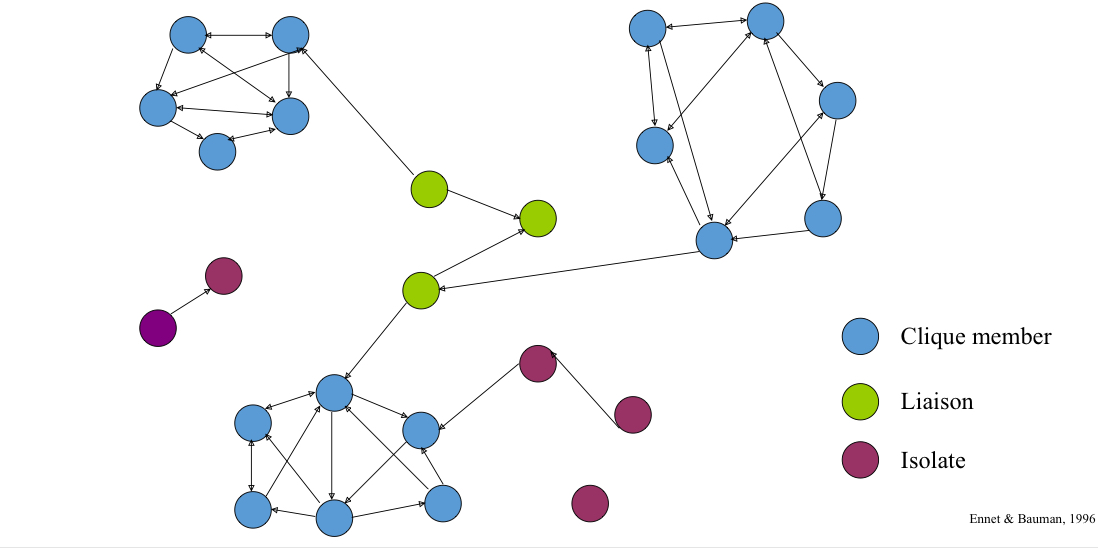
Predictors of Clique and Friendship Formation
Rarely a free choice as initially thought to be
Due to factors in the environment and of self:
Age
Gender/Sex (less important in later adolescence)
Social Class
Ethnicity/Race (not as important in early childhood, more in later adolescence)
Academic Performance/School Orientation
Involvement in Antisocial Activities
Shared Interests
Peer Crowds
Distinct from the idea of cliques
Large, reputation-based collectives of similarly stereotyped individuals who may or may not spend time together
Vary in terms of:
Involvement of adult institutions
Involvement in peer culture
Membership based mainly on reputation and stereotypes
There is no choice in the involvement of peer crowds, may be unknown to categorized individual
Functions of Peer Crowds
Locate adolescence within the social structure of the school
Channel adolescents into associations with some peer and away from others
Provide contexts that reward certain lifestyle and disparage others
Types of Peer Crowds — in 1990!
Vary across high schools, but will remain on the displayed on the dimensions

Selection v. Socialization
Selection:
Adolescent join peer groups that are similar to themselves
Socialization:
Peer groups make adolescents similar to one another
Popularity and Social Status
Sociometric popularity:
How well-liked someone may be
Perceived popularity:
Perceived social status
Aggressive individuals tend to be higher status
Aggression:
Some forms predict popularity early in adolescence, but kindness and pro-sociality become more important over time
Studies show that popularity is not always the greatest thing
Those with some level of popularity have better social satisfaction, self-concept, and friendship quality
Those with highest levels have lessened satisfaction levels
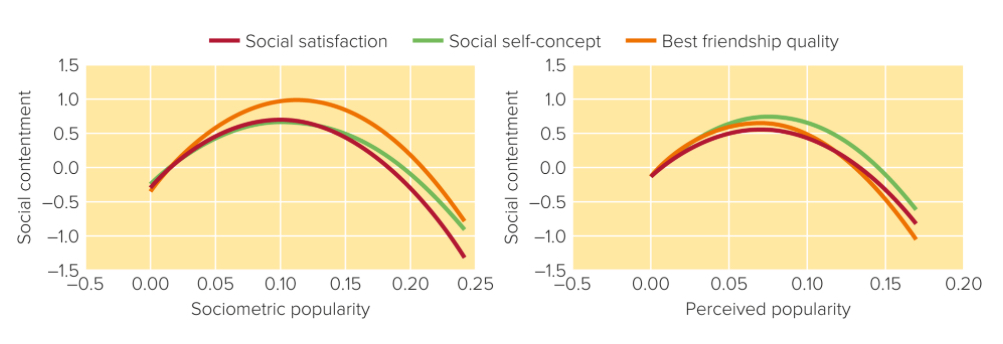
The Societal Role of Peers
Postfigurative Cultures: (Model of adulthood comes from the past)
Static, experiencing little to no change
Future adult world of adolescent is equal to that of their elders
Parents and older elders are primary socializers
Cofigurative Cultures: (Model of adulthood comes equally from peers and parents)
Moderate rate of social change
Adult world of adolescent will different from that of elders
Peers become as important socializers as parents
Prefigurative Cultures: (Model of adulthood is taught by peers and children)
Extremely rapid rate of social change
Adult world of adolescents will have nothing to do with that of elders
Adolescents and peers will become socializers of parents
Historical Trends and Role of Peers
Clear Transition → Particularistic Norms (Family-Specific)
Particularistic Norms → Family is Primary Socializer
Industrial Revolution:
Unclear Transition → Universalistic Norms
Universalistic Norms → Peers Become Important Socializers
Key Questions (Gardner, Peer Risk-Taking)
Is risk taking higher among adolescents than adults?
Is there greater risk taking in the presence of peers?
Is the impact of peers greatest during adolescence?
Sample and Method (Gardner, Peer RiskTaking)
Three age groups: 13-16, 18-22, 24-older
Two conditions: alone vs. a triad of friends
Three measures:
Risk preference: Reported cost-benefits of risky scenarios
Risky decision-making: Reported decisions in risky scenarios
Risk taking: Behavior in “Chicken” video game

Results (Gardner, Peer RiskTaking)
Risk taking and risky decision making decreased with age
Presence of peers increases risk taking, risky decision making, and more focus on benefits of risk taking
The effect of the presence of peers on risk taking and risky decision making was greater for adolescents
Indication of risky driving
Bars are decreasing with older ages
Greater for adolescence, greater differential risk-taking
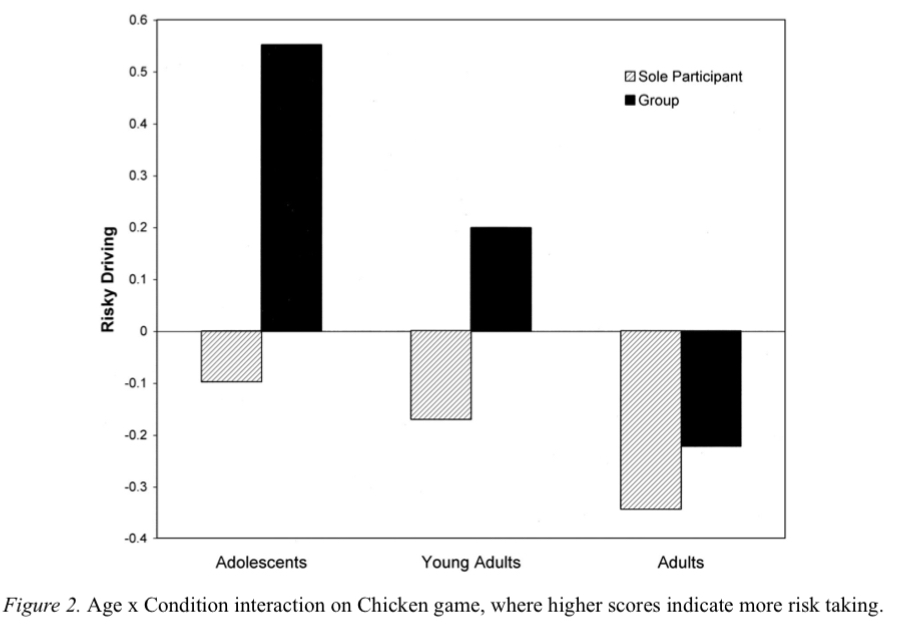
Discussion and Implications (Gardner, Peer Risktaking)
Adolescents are riskier despite understanding the costs of risk-taking
Peers may be an important source of higher levels of risk-taking during adolescence because of the greater susceptibility to peer influence
Can’t change risky behavior, but can change the context of risky behavior

Peers, RiskTaking, and Reward Circuitry
Ventral striatum is more active with peers during adolescence, making decision-making
As compared to Y.A. and Adults
Similar with lateral prefrontal cortex
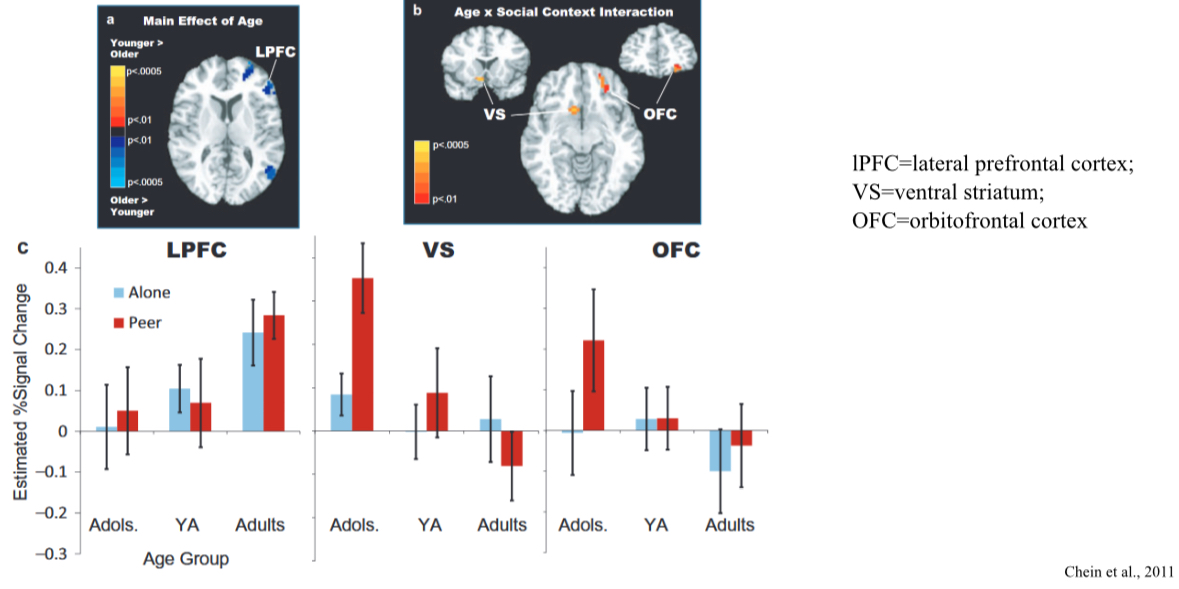
Even in Mice
Juvenile mice spent more time drinking when with peers than alone (activated socially)
For adult mice, there was no difference with peers and without
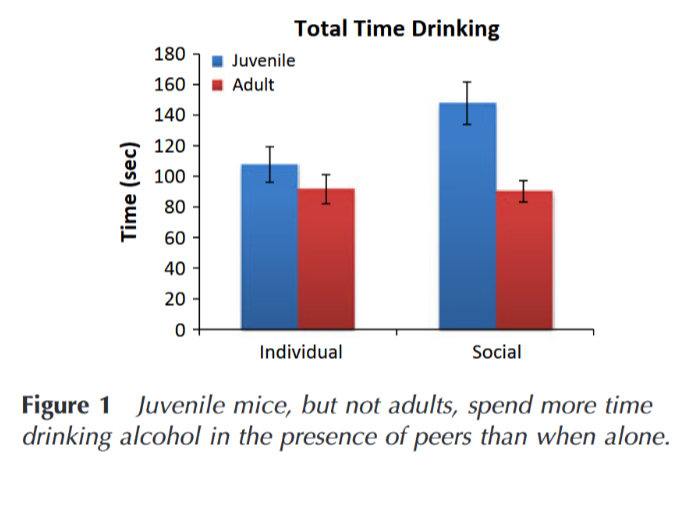
Peers also Influence Prosocial Behavior
Seeing another individual act prosocially, adolescence were more likely to act prosocially as well
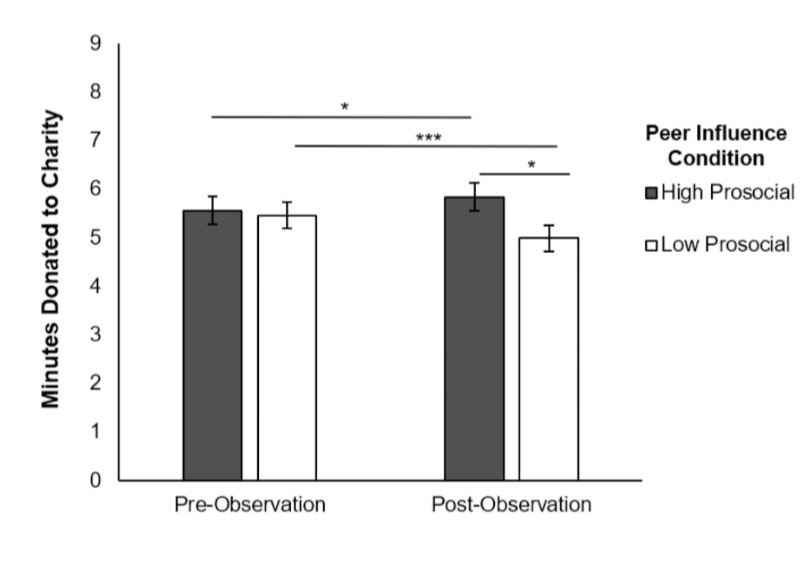
Prosocial RiskTaking
“Many young people are inclined toward risk taking and also toward helping other people. Prosocial risk taking is a term that can describe different ways that youth provide significant instrumental and emotional support to family members, friends, and strangers, even when it involves a personal risk.
Research to date suggests that young people are more likely to engage in prosocial risk taking when they are more tolerant of uncertainty, have greater sensation-seeking, perspective-taking, and empathy, and when they are motivated by reputational concerns.
Providing opportunities for youth to direct their risk-taking tendencies toward prosocial outlets may help minimize risks to their psychosocial health and promote individual and community well-being.”
Positive RiskTaking
Risk-taking is not inherently negative, some developmentally appropriate
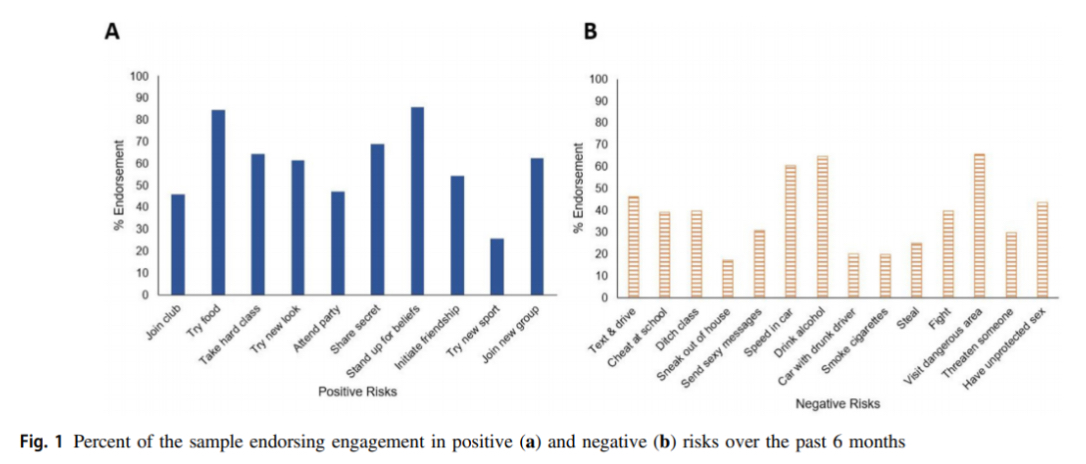
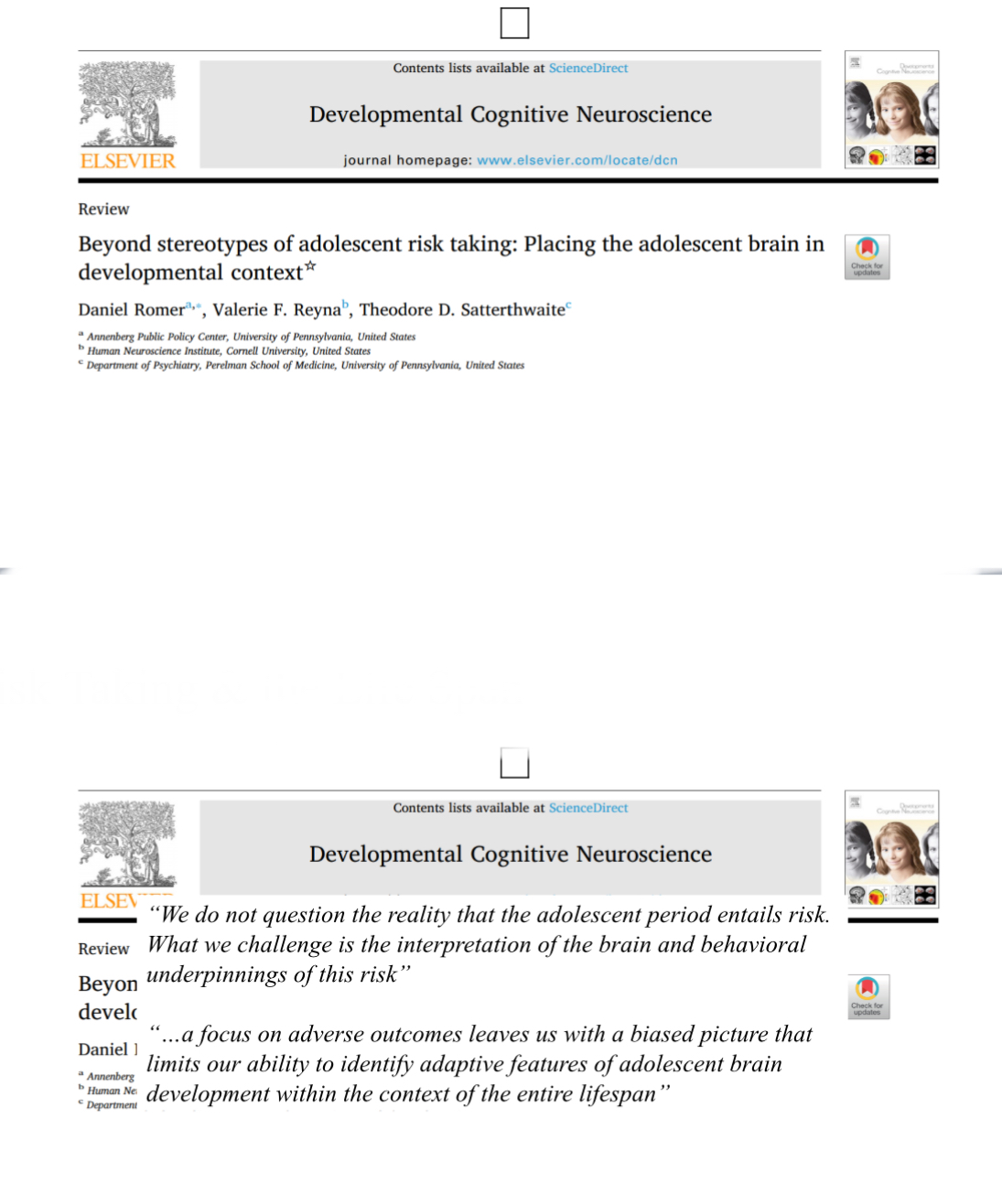
Risk Taking and Lifespan
Risk-taking is fundamentally part of adolescence development
Younger are more likely to take risks to find answers or solutions
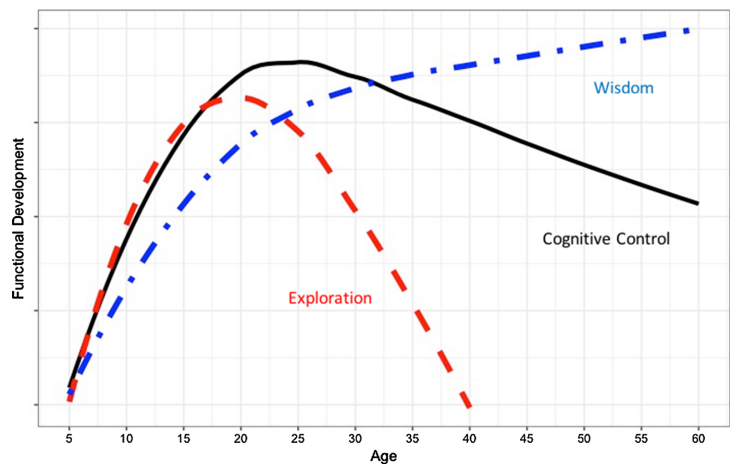
Erik Erikson (1902-1994)
Trained in Freudian Psychoanalysis, but moved away
Influenced by surged in anthropological research, looking into role social forces play in development
Became ego-psychologist (placed emphasis on ego, not on destructive impulsive on ID)
Epigenetic Principle of Development
“Anything that grows has a ground plan, and that out of this ground plan the parts arise, each part having its time of special ascendancy, until all parts have risen to form a functional whole”
Develop according to plan inherit to us as a species (an orderly process of development)
Erikson’s Eight Stages of Development
Eight stage model of psychosocial development
Psychosocial conflicts with two potential outcomes
One stages solution will influence another stages outcome
How trust v mistrust is solved will impact solution to identity v confusion
Identity crisis (5th stage) has individuals to confront need to develop coherent sense of identity
Not every fully resolved, can occur at any time in life (divorce, new career)
Adolescence need to resolve initial identities to better adjust to later identity crises
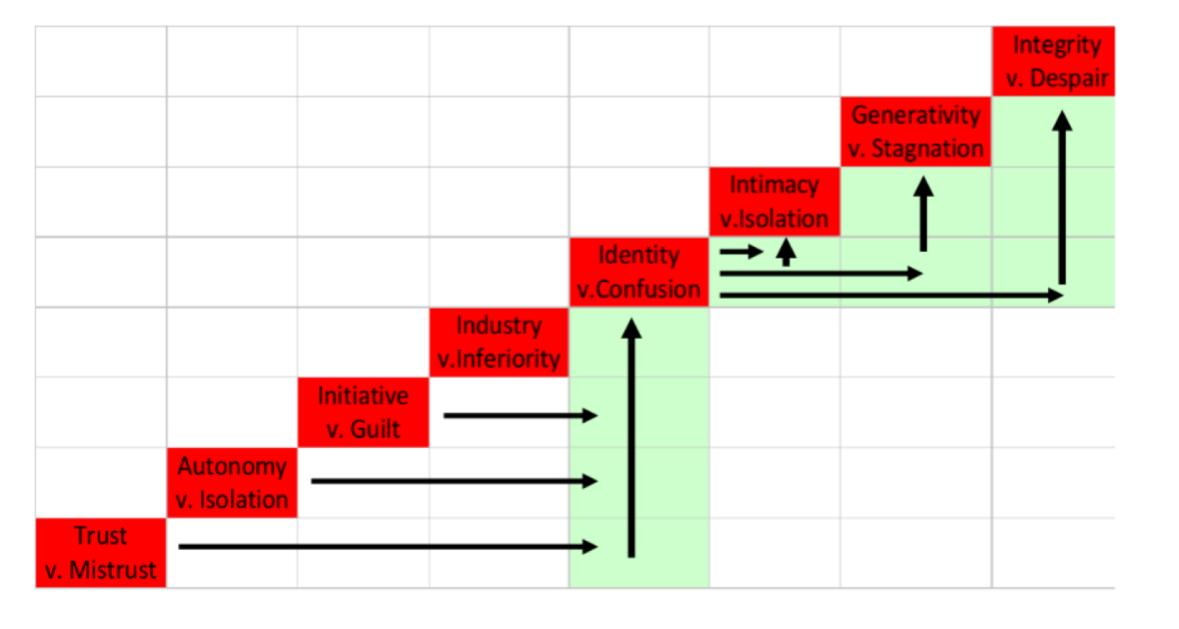
Marcia’s Identity Statuses
Based on Erikson’s stage theory
To what extent an identity has been committed to, or explored
Explored and committed to identity = Identity Achievement
Explored and not committed to identity = Moratorium
Not explored and committed to identity = Foreclosure (‘fore’-others)
Not explored and not committed to identity = Diffusion
Identity Statuses and Individual Characteristics
Achievement
Healthiest, most balanced
Moratorium
Anxious, but openly searching
Foreclosure
Most rigid, least autonomous
Diffusion
Most problems, not well integrated socially
No real sense of self
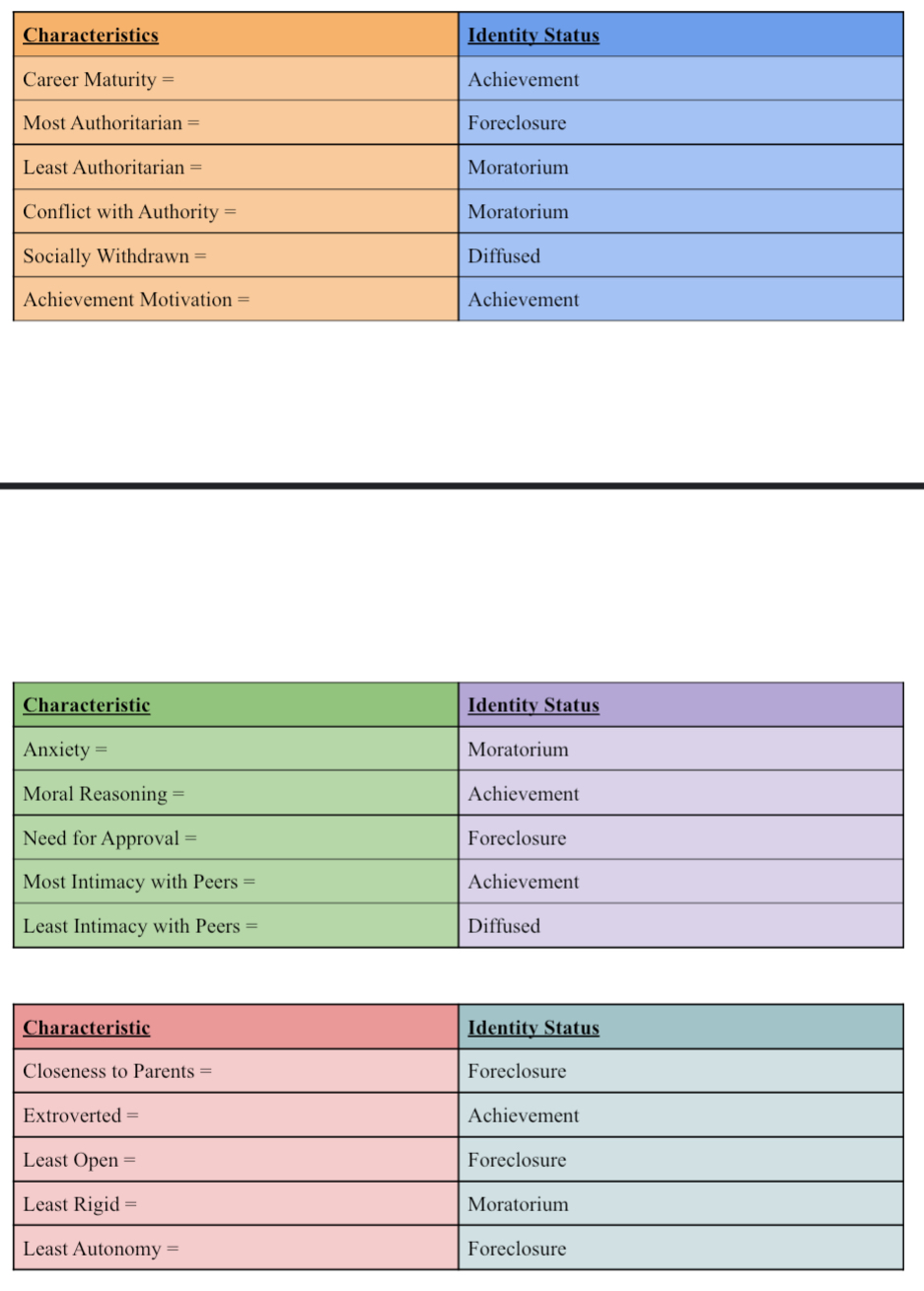
Self Concept and Social Identity
Greater differentiation in self concept
Children will think they are generally good at several things
Adolescence will find they are better at some things more than others
Or will think of themselves as one way with family and another with friends
Increased importance of social identities
Gender, ethnicity, religion, etc
Social identities often assigned
Receipt of positive and negative treatment
These processes happen due to development in social brain
Key regions relevant for thinking of selves, others, and how others think of us
Pruning in parietal and prefrontal areas, responsible for social identity and cognition
Brain regions aren’t just experiencing pruning, begin to connect to one another
Connection between TPJ, Medial prefrontal, and ventral striatum
